AIR TRANSPORT ATR at 40
Top of the Props at 40
This November, regional aircraft consortium ATR celebrates its 40th anniversary. TIM ROBINSON FRAeS looks at how the turboprop manufacturer is staying ahead of the game four decades on.
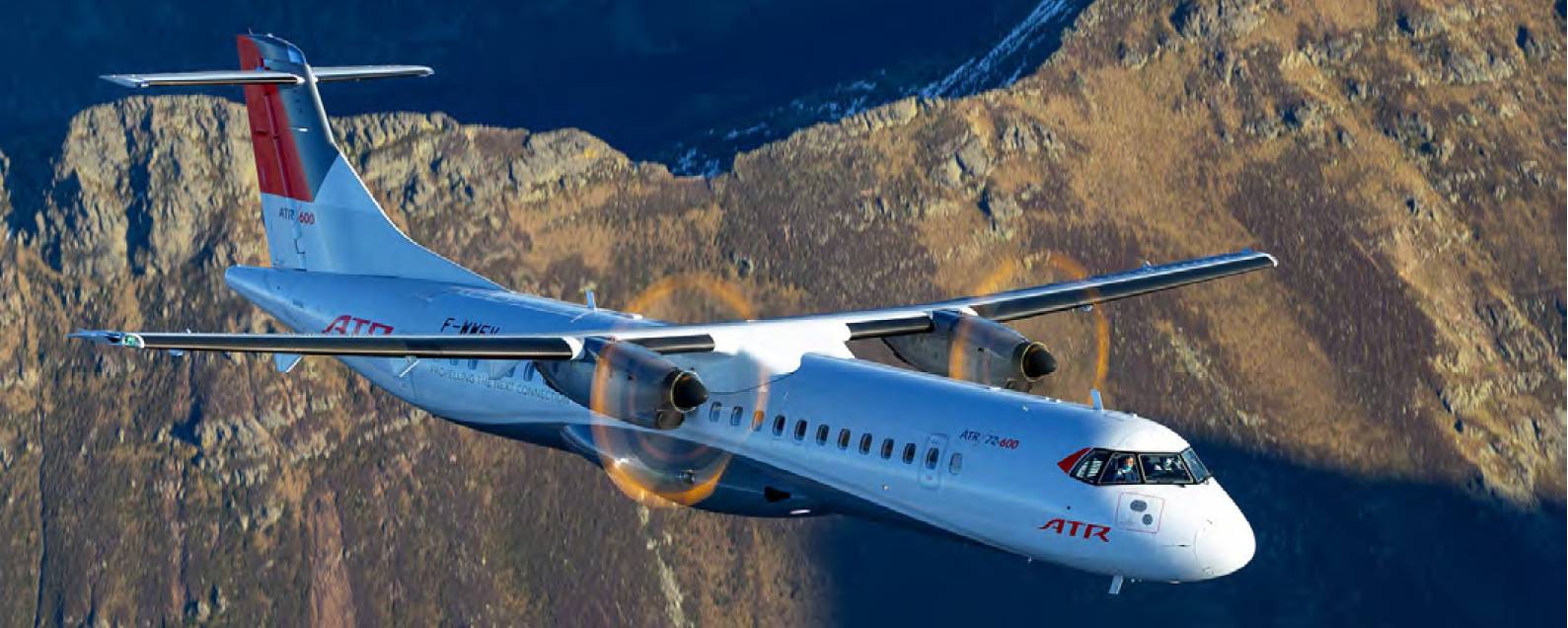 ATR Aircraft
ATR Aircraft
There is no doubt that regional aviation is a tough business – with razor-thin margins for operators flying routes that can connect remote communities. The same might be said for manufacturers. Since ATR was formed as a joint venture between Airbus and Leonardo (then Aérospatiale and Aeritalia) in 1981, it has seen a number of rivals exit the regional airliner business – such as Fokker, BAE Systems, Saab and Dornier – although the latter is aiming to make a comeback.
Its biggest rival in turboprops, Canada’s Bombardier, is a shell of its former self after overextending with the CSeries and selling off its Dash 8 Q400 family to Longview Aviation. While there is competition on the horizon from Embraer’s future turboprop, at present ATR is arguably ‘the last man standing’.
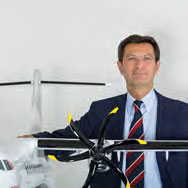 Stefano Bortoli (ATR Aircraft)
Stefano Bortoli (ATR Aircraft)
As well as its 40th anniversary this month, this year will also see ATR celebrate its 1,600th delivery of a regional turboprop. Its products, the ATR 42 and ATR 72, are the best sellers in the 50-90 regional airliner market with ATR claiming 76% market dominance in firm orders over the Dash 8-400 since 2011. Against regional jets in the same size category, such as the CRJ700/900 and E170/ E175, ATR has a respectable 38% of the market.
Part of ATR’s success then, is that it has stuck to its core business of regional and not expanded into risky ventures, such as regional jets or adjacent markets. However, the flip side of this is there is also the sense that its ambitions have been carefully held in check by its partners.
Previous concepts to launch a brand new larger 90-100 seat stretched model of the ATR came to naught, most likely as this would have begun nudging up against the 107-seat ‘baby’ Airbus A318.
A factory with history
Based in Toulouse, ATR’s factory with its natural light roof is one steeped in aviation history, from producing Dewoitine fighters just before WW2, to the Franco-German Transall, and most famously of all, Concorde. Both the metal wing ATR 42 and the composite wing ATR 72, as well as the new ATR 72600F cargo variant are produced on the same line.
Today, the effect of the coronavirus pandemic has meant that production has slowed to just two a month, with the airframer aiming to increase to five a month by 2025. At the time of AEROSPACE’s visit in September, the factory also had around 25 airframes in a backlog for completion and delivery to customers, with the intention to double the deliveries in 2021 from the 10 it handed over in 2020.
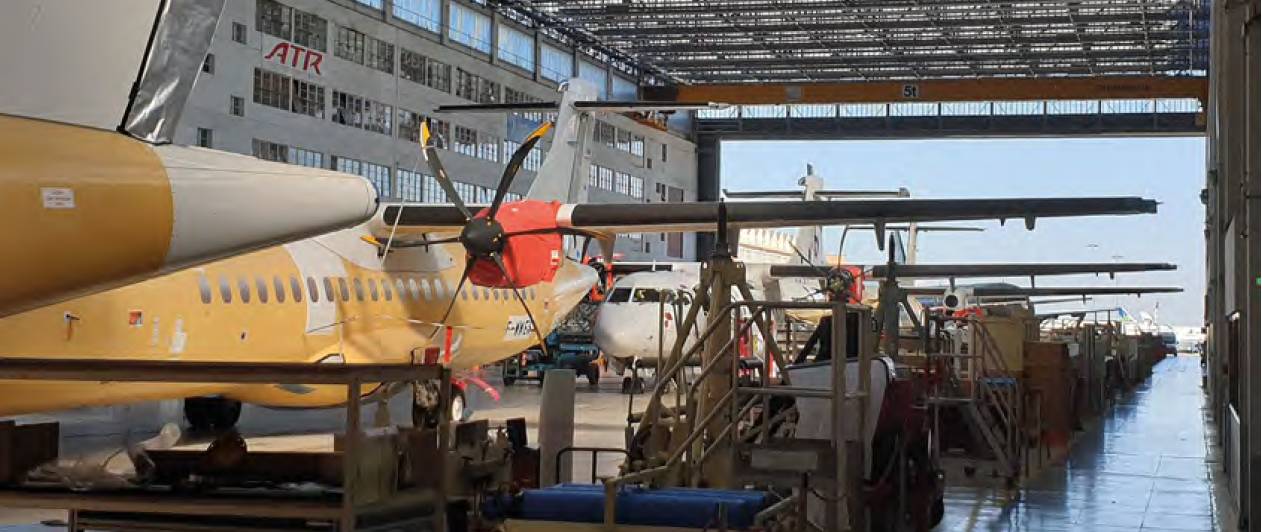 Tim Robinson/RAeS
Tim Robinson/RAeS
Worldwide customers
One impressive aspect of ATR is that, with a tiny workforce (1,200) compared to parent groups Airbus and Leonardo, it still has to support a varied set of over 200 operators from all around the globe – from the Arctic to the Pacific and from cargo to military users, such as maritime patrol aircraft and special missions. Many of these airlines could be operating ‘microfleets’ of just two or three aircraft – yet will still expect the 24/7 AOG support and responsiveness afforded larger carriers. Says ATR CEO Stefano Bortoli: “We are a tiny company, but active all around the world”.
Meanwhile, the Covid-19 crisis has significantly impacted ATR’s customer base, with the company working hard to reinforce relationships and support its airlines. For example, with passenger flying grounded in many parts of the world, it quickly made available a solution to convert a passenger configuration to a cargo one overnight to keep its customers fying.
New models, new innovation
While ATR has stuck closely to its strategy of two basic models over the past four decades – the ATR 42 and ATR 72 it has recently launched two derivatives to expand its family with two new models – the 42-600S STOL variant announced in 2019 and a new-build 72-600F cargo variant launched in 2017 with an order for 30 firm and 20 options from FedEx.
WE ARE A TINY COMPANY BUT ACTIVE ALL AROUND THE WORLD
Stefano Bortoli
CEO, ATR
Despite focusing on these two base models in the past 40 years, ATR has not rested on its laurels in improving and bringing the latest technology and advances to its products. The cockpit of the -600, for example, with five large screens is a far cry from the steam gauges of the original. The flight deck also features the latest in performance-based navigation standards, including VNAV, (vertical navigation) LPV (localiser performance with vertical guidance) and RNP AR 0.3/0.3 (required navigation performance) which allows for complex precision landings. As well as the obvious safety benefit of these in mountainous terrain, this saves fuel by more direct routes, fewer holds and missed approaches.
ATR is also breaking new ground in becoming the first commercial airliner manufacturer to introduce a head-mounted display (HMD) into the cockpit with its Clearvision HMD. The system, similar to the kind of advanced HMDs worn by fighter pilots, uses the latest technology to shrink this to a pair of lightweight goggles. This allows flight symbology and IR video from the EVS (enhanced vision system) or SVS (synthetic vision system) to be presented in front of the pilots’ eyes, wherever they look – providing enhanced situational awareness in bad weather or at night.
A cabin that feels like a larger jet
Meanwhile, in the rear, ATR has also been busy in upgrading the passenger cabin, which now matches the experience of A320s and larger jets – with a number of details found in mainline airliners. Since 2016, ATR has been offering the ultra-lightweight (<4kg) Titanium Seat from ExpliSeat, which can save operators up to 300kg on ATR -600 cabin configuration. Additionally, the large overhead baggage bins feature a roller opening mechanism, meaning that doors are kept clear of hitting taller passengers. A Smart Galley allows for reconfiguration. The latest cabin also features wi-fi to allow passengers to connect their own devices for IFE.
Upgauging at regional operators
While airlines in some markets are ‘downgauging’ to smaller narrowbodies, ATR sees a growing market for potential operators in the 30-50-seat range trading up to newer aircraft from older types. There are now over 900+ ageing turboprops in the 70-seat and below bracket that will need replacing in the coming years – double the number since ten years ago. These include Dash 100/200/300, Saab 340s and Embraer Brasilias – with the biggest airline fleet renewal opportunities being in the US, Australia and Canada.
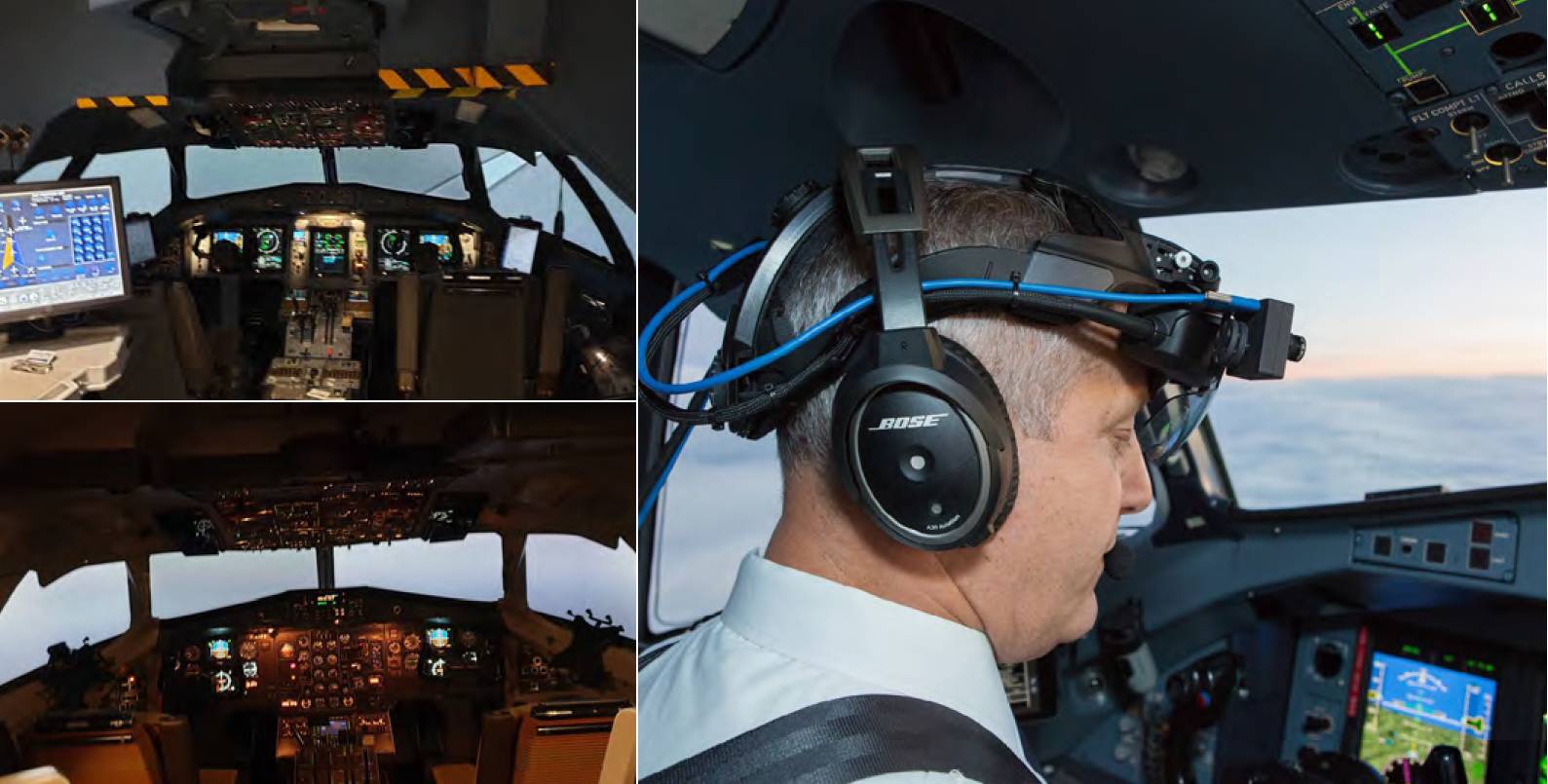 Evolution of the ATR flight deck. From bottom left, clockwise, ATR 42-500 simulator in the company’s training centre in Toulouse, the latest ATR 72-600 flight simulator and the Clearvision head-mounted display (HMD) now offered as an option. Tim Robinson/RAeS; Tim Robinson/RAeS; ATR Aircraft
Evolution of the ATR flight deck. From bottom left, clockwise, ATR 42-500 simulator in the company’s training centre in Toulouse, the latest ATR 72-600 flight simulator and the Clearvision head-mounted display (HMD) now offered as an option. Tim Robinson/RAeS; Tim Robinson/RAeS; ATR Aircraft
Indeed, the launch of the STOL (short take-off and landing) variant of the ATR 42, with its ability to operate from 800m strips, with 40 passengers has also been attracting attention in the sub-40-seat category, from operators of aircraft, such as the Twin Otter and Islander as a way of upgauging or using it as a combi-passenger/freighter for remote regions. Air Tahiti, for example, will replace its 19-seat Twin Otters with the ATR 42-600S STOL, while PNG Air is set to replace its 37-seat Dash 8-100s too. All told, ATR says that the ATR 42-600S will open up an additional 500+ airports able to operate the STOL variant of the turbprop airliner.
One under-exploited market for ATR is still China, where certification of its latest 42-600 is still held up for unknown reasons, with expected approval slipping from autumn of 2020 to mid-2022. While industry insiders speculate that this could be down to the pandemic, increased workload at Civil Aviation Authority of China (CAAC) of certificating the Comac C919 or potentially the fact that China has its own regional turboprop, the MA700 waiting in the wings, ATR, is careful not to be drawn on the reasons for this delay.
For the freighter good
Another opportunity, says ATR will be in the regional cargo segment, with the Covid-19 pandemic highlighting the value and importance of air freight as the world went into lockdown. Cargo activity has already surpassed 2019 pre-Covid levels in the first months of 2021 and the company says that in the past two years the number of cargo flights has increased by 72%.
Even as travel restrictions lift, the acceleration of e-commerce, remote working and the vaccine rollout to remote areas means that this momentum in the airfreight sector is likely to continue. While there are 130 ATR freighters flying today, ATR expects that there is a market potential of 460 turboprop cargo aircraft (both new and used) over the next 20 years. Its new ATR 72-600F, which first flew in September 2020, is thus aimed at this market.
Hydrogen power?
With its parent group Airbus now aiming to fast-track hydrogen as a fuel for zero-carbon aviation, ATR is also in the unique position of potentially being able to take advantage and ‘piggyback’ on this – with Airbus saying that it expects hydrogen-powered regional aircraft to be the first applications.
However, ATR itself is more cautious on the matter. It says that it intends to explore Universal Hydrogen’s technology – a start-up from ex-Airbus CTO Paul Eremenko, that coincidently is opening an R&D engineering centre in Toulouse, with the intent to convert an ATR turboprop to this zero-carbon fuel. Says ATR CEO Bortoli: “We have a lot to bring to them, we have to understand what they bring to us”.
Despite these potential paths to zero-carbon regional airliners, ATR also points out there are financial and operational challenges to be solved in bringing hydrogen to regional aviation. For one, will its small regional airline customers, with limited funds for fleet renewal compared to the major airlines, be in the position to buy a zero-carbon airliner that potentially could be more expensive than a conventional turboprop?
Secondly, there are operational challenges – with ATR operators regularly flying into austere and remote airstrips, as well as regional airports. This not only means that aircraft need to be durable and rugged to operate from gravel and dirt strips but also these remote airports make it far harder to develop the kind of hydrogen infrastructure that would support zero-carbon aviation.
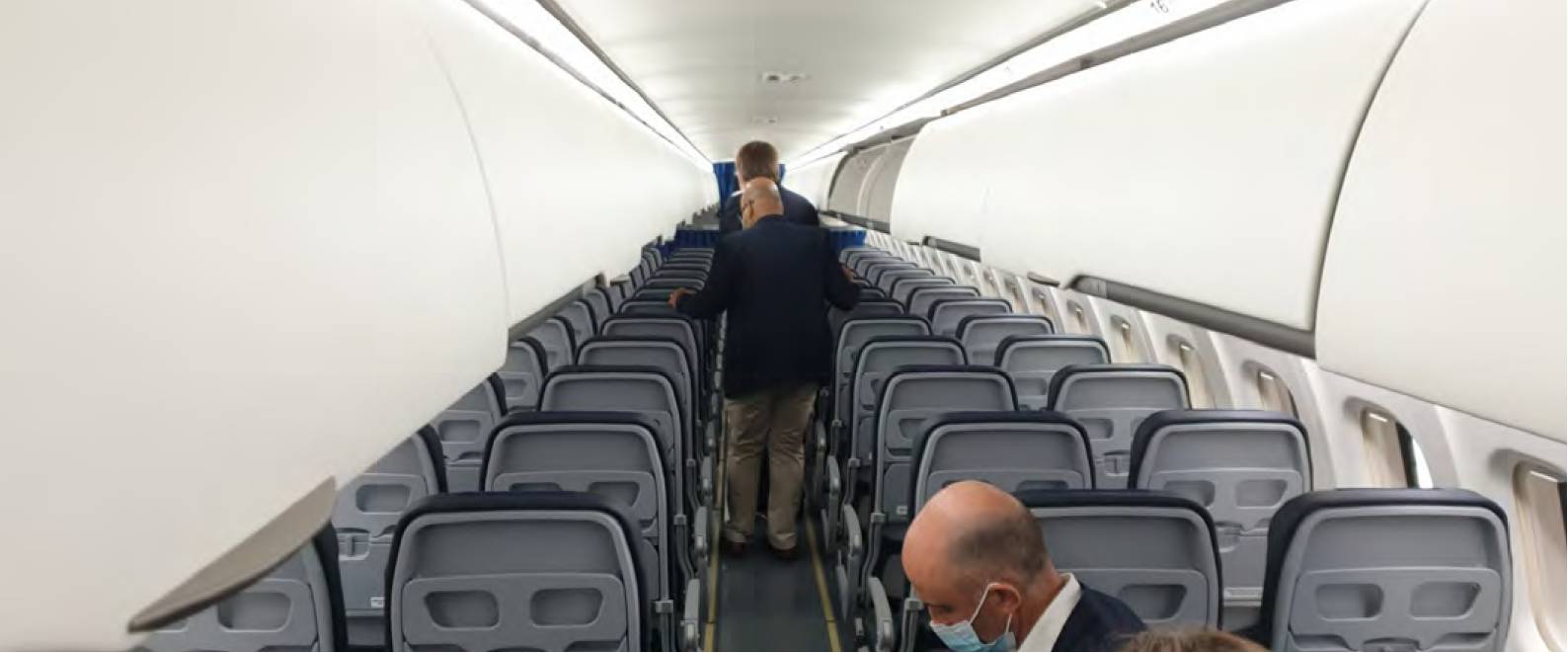 Interior of a TAROM ATR 72-600 with NeoPrestige interior ready for delivery at Toulouse. Tim Robinson/RAeS
Interior of a TAROM ATR 72-600 with NeoPrestige interior ready for delivery at Toulouse. Tim Robinson/RAeS
Leading the way in responsible regional flying
This does not mean, however, that ATR is a lone hold-out against the growing momentum of sustainable regional aviation. Indeed, in some areas, it is already leading the way in many respects. Ultra-lightweight cabin seats and precision navigation all save fuel and its fuel-sipping turboprops already save -40% C02 2 emissions compared to a similar-sized regional jet and half the NOx produced on take-off and landing. ATR’s products, meanwhile, are more considerate to communities around airports, with a noise footprint three times smaller than jets.
ATR is also making strides in converting its aircraft to run on SAF (sustainable aviation fuel) and achieving 100% SAF compatibility by 2025. In 2019, with its Swedish customer Braathens Regional Airlines –and biofuel suppliers Air BP and Finnish Neste, ATR conducted a ‘perfect flight’ between Halmstad and Stockholm Bromma – achieving a 46% reduction in emissions with a 50% blend, direct routing and optimised flight altitude.
In 2022, ATR will repeat this ‘perfect flight’ with Braathens with 100% biofuel on one engine with the aim of reducing emissions by 64% compared to a normal flight in regular conditions. These tests then, a step along the way to 100% SAF compatibility in 2025, show what can be done with existing technology and operational improvements.
Summary
There is no doubt that ATR has benefited from the support and deep pockets of its two large OEM parent groups in the form of Airbus and Leonardo – giving it a strong foundation to lean on, when others have exited this small, yet challenging, sector. With arch turboprop rival Bombardier gone, the next challenger is set to be Embraer with a clean-sheet turboprop with rear-mounted engines.
Yet the rapidly expanding cargo market and the large replacement market for 30-seat and up older turboprops will keep ATR busy for years.
However, it is notable that, as electric, hybrid-electric and hydrogen aircraft develop, it may be from the smaller end of the market first but CEO Bortoli notes that, while ATR will consider any new green technology, it will need to be “available and affordable” before it is adopted.
 ATR Aircraft
ATR Aircraft Stefano Bortoli (ATR Aircraft)
Stefano Bortoli (ATR Aircraft) Tim Robinson/RAeS
Tim Robinson/RAeS
